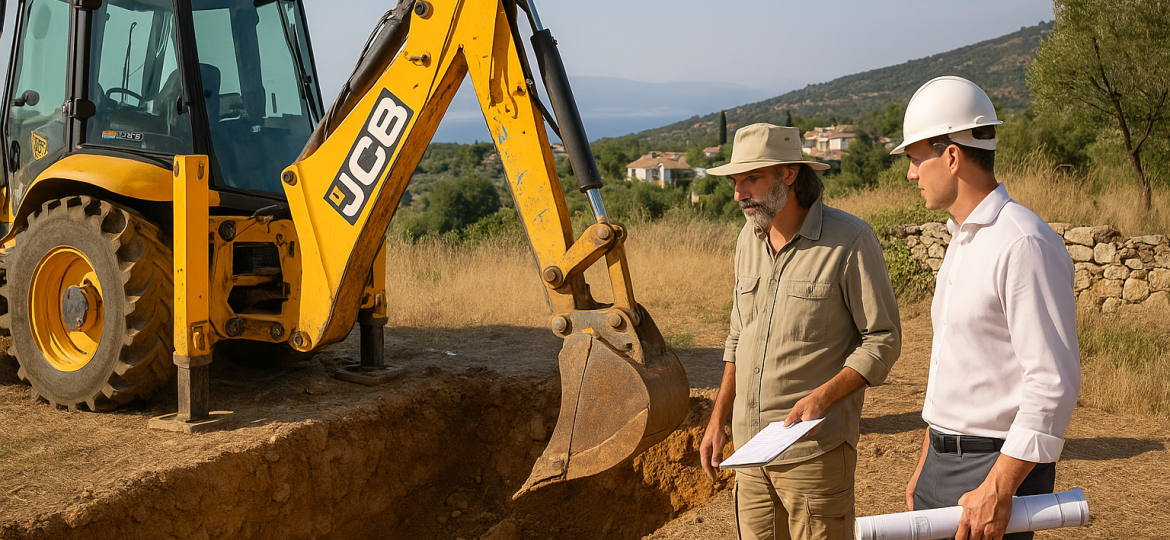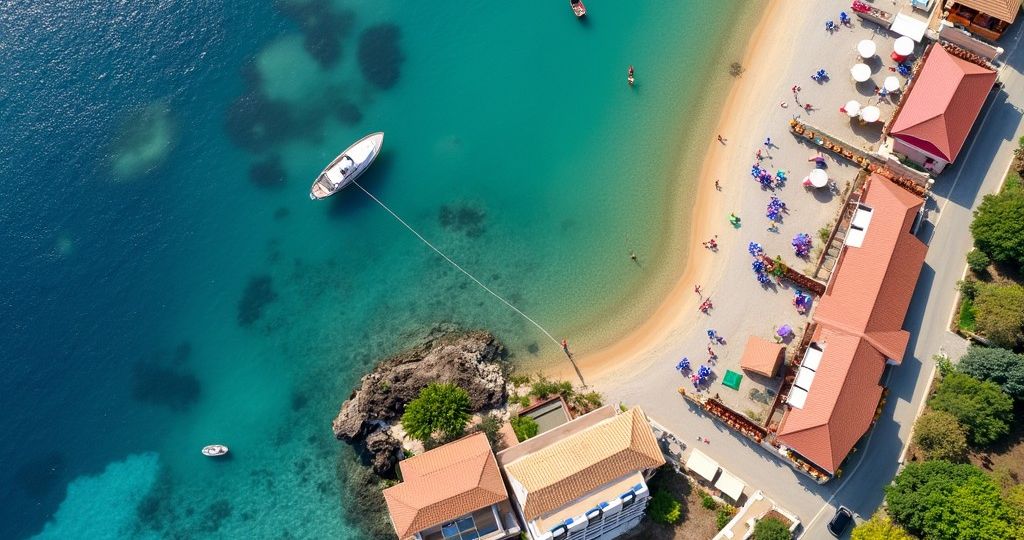Kalimera! We know numbers and regulations can make your head spin faster than a Greek plate dance. Therefore today, we break down on residential building coverage in the greek building regulations, and guide you through the process of calculating it. So grab a cup of Greek coffee, and get ready to crunch some numbers with us.
Building coverage refers to the proportion of land occupied by the footprint of certain buildings or structures on a property. It’s a vital metric that determines how much of your precious land can be utilized for construction. Understanding the factors influencing building coverage is crucial, so let’s explore them together.
To begin, you’ll want to locate your building coverage limit. Your survey map, also known as a topography survey, holds the key to this information. Look for the expression of your building coverage limit in numbers or percentages next to the term “ΚΑΛΥΨΗ” on the survey.
If this information isn’t available, try looking for the description of your property on the survey, and determine whether your property falls within a rural area (ΕΚΤΟΣ ΣΧΕΔΙΟΥ), a village area (ΕΝΤΟΣ ΟΙΚΙΣΜΟΥ), or a city area (ΕΝΤΟΣ ΣΧΕΔΙΟΥ).
Now, let’s break it down based on property type:
1) rural properties
in rural properties (ΕΚΤΟΣ ΣΧΕΔΙΟΥ) and for residential usage, building coverage is limited to 10% of the total property area. This means that the combined footprint of structures must not exceed 10% of the property’s size. Keep in mind that rural properties smaller than 4,000 sq m cannot build.
2) village or city properties
If your property lies within a village (ΕΝΤΟΣ ΟΙΚΙΣΜΟΥ) or city boundary (ΕΝΤΟΣ ΣΧΕΔΙΟΥ) the residential building coverage limit is set at 60%. This means that the total area occupied by all structures must not surpass 60% of the property’s size. However, if your property cannot achieve a building coverage of 120 sqm, the limit can be increased up to 70% of the plot area, as long as it remains under 120 sqm.
Now let’s summarize the building coverage limits:
Rural Properties:
- 10%
Village or City Properties:
- for properties 200 sqm & over : 60%
- for properties between 171.43 and under 200 sqm: 120 SQM
- for properties up to 171.43 sqm: 70%
To calculate and verify your actual building coverage, follow these steps:
-
- Determine the total area of your property.
-
- Multiply the property area by the building coverage limit specific to your property type.
-
- Identify all structures contributing to the building coverage.
-
- Calculate the combined footprint of these structures.
-
- Ensure that the calculated building coverage does not exceed the allowed limit.
Now, let’s tackle the million-drachma question: what actually counts in the coverage calculation? Here’s the lowdown:
Counted in the Calculation:
-
- The outline of enclosed areas of the building.
-
- Semi-outdoor spaces, known as “ημιυπαίθριοι χώροι” (we’ll dig deeper into this in future posts).
Excluded from the Calculation:
- open air recesses in a building’s facade regardless of their size or presence of load-bearing elements
- balconies & closed balconies (those fancy bay-style extrusions on the facade)
- basements within the footprint of the above-ground building
- Vertical open-air openings throughout the building (from ground or underground level to roof), not covered by any structure and only for the portion not covered by a structure
- if you are on village or city property, a trash collection accessory structure, as long as it meets certain size and usage criteria
And there you have it.
If you cannot find your building coverage limit number, or property description on your survey map, it’s wise to seek assistance from a professional topographer. They can thoroughly research and uncover the necessary building regulations specific to your property. Remember, appearances can be deceiving, and what may seem unbuildable at first glance might just hold untapped potential.
If you have any questions or need personalized guidance regarding the building coverage regulations that apply to your specific situation, we encourage you to leave your questions in the comments section below. Our team of experts and fellow readers will be more than happy to assist you and share their knowledge. Your question may not only benefit you but also others who are navigating the same path. We look forward to hearing from you and helping you on your building journey in Greece!




16 Comments
Can one assume that outbuildings in rural areas, such as garages and barns and covered walkways are counted as coverage?
yes, these are all counted in coverage. There is an exception for a small storage building that would not be counted in the coverage on agricultural land but you & your land would need to be registered with the department of agriculture to apply for this exception
Hello, I have found your information on Building Coverage and Building Regulations extremely helpful and your illustrations are excellent. I read the following on another website: “Although the changing law has reduced the sq.m in building limits, it gives an advantage to the two-storeys or two-storeys with a basement or a storey with basement houses.
The previous law gave the right to build 200 sq.m plus 12 sq.m for the staircase, but the new one gives the right to build an extra 25 sq.m for the stairs.” So for example if you have a 4000m2 plot and you are building a ground and first floor your allowance is 186m2 plus 25m? I am interested in renovating and extending an existing building which needs the layout changed and the existing stairs removed and new stairs in a new position fitted. The villa is in Lefkada. Thank you.
reorginasition
Hi Martin, this regulation gives you the right to subtract up to 25 sq m of stairs and circulation leading to the stair from the allowable building area per floor. So if the total area taken up by the stair and circulation to the stair (hallway) is less then 25 sq m you can only subtract the lesser amount. There are many more extras you can subtract apart from the stairs and circulation to the stair to extend your building, well informed engineers that have taken the time to analyze new codes will be able to deduct these areas citing the appropriate codes on each instance
Buongiorno, vorrei sapere per cortesia se le pergole (tipiche delle case cicladiche, in questo caso a Kythnos) contribuiscono al conteggio della superficie edificabile o dell’impronta…
Poi vi chiedo: la distanza da confine / strada rurale dell’eventuale nuovo edificio è tassativamente 15 metri?
Grazie! Diego
Ciao Diego, your pergola does not count in the allowable building area, if however it is covered with a solid material (as in it does not allow water to pass through it’s ‘roof’) then it’s considered a ‘covered patio’ (stegastro) and those have other regulations and restrictions.
To answer your 15m setback question I would need to see your survey map
Can the basement which includes also a garage cover more space than the house above ground? In other words, can the basement independently reach the maximum of the 10% of the plot size?
If your land is rural, then your basement can only extend to the outline of the building coverage you are creating on the ground floor
Is there a law relating to height of chimney pipes for wood burning stoves
yes, as a general rule of thumb the chimney must terminate at least 1 meter above it’s exit point, and be located at least 1.5 meters from combustible materials
Hello. I have an agricultural land about 2.000 sm. Can you tell me please if i need small scale authorisation in case that I want to build a closed gazebo from OSB, to surround the land with a fence without a foundation and to to make a cement driveway. Or for this kind of think is not necesarry authorisation.Thank you. Gabriela
Hi Gabriela, please define ‘closed’, do you mean the top is closed (water won’t pass through), or the sides are closed (creating a building)
Multumesc pentru raspuns. Partea de sus sa fie inchisa – apa nu va trece – si daca pot inchide 3 laterale. cu OSB , asemenea unei cladiri. Multumesc
Gabriela, if you plan to have a closed top (like you explain) then you will need a full on permit. If any of the sides get closed, then under greek building regulation it’s considered a building and needs a full on permit (in both conditions you need to check that your property can build)
Kalistera 🙂 I have been told, that in my area the “total cover at the plot” and the “total area of the buildings” are 200m2 each and the “total sq.m. of the semi opened areas” (covered ground terrace or parking lot ) is 40m2. Does it mean 240m2 together or only 200m2 ?
Καλημέρα and thank you for your great question! 😊
When you’re told that:
* “Total cover on the plot” = 200 m² (Κάλυψη),
* “Total area of the buildings” = 200 m² (Δόμηση), and
* “Covered semi-open areas” (like terraces or covered parking) = 40 m²,
we need to carefully understand what each of these terms means, because they do not simply add up together.
🔹 Does 200 m² + 40 m² = 240 m²?
Not necessarily. It depends on the case — and here’s why:
When Coverage (Κάλυψη) = Building Area (Δόμηση)
In some cases — typically in rural plots (εκτός σχεδίου) — the ground coverage and the allowable building area are equal (e.g. 200 m²).
In such situations, semi-open spaces (ημιυπαίθριοι) like covered terraces are counted within the coverage (Κάλυψη) but not in the building area (Δόμηση).
So if you’re allowed 200 m² total coverage, and you build:
* 160 m² of enclosed building (main structure), and
* 40 m² of covered semi-open areas (e.g. covered terrace),
➡️ You’ve reached the limit of 200 m² coverage, and your building area remains at 160 m².
Keep in mind: semi-open areas do not increase your allowable building size.
They are usually excluded from the Σ.Δ. (building factor), but do count toward the coverage, unless the regulations in your area say otherwise.
Also keep in mind, you can now build semi open spaces of lightweight construction (not concrete) that under certain conditions do not count at all in your building factor and/or coverage – any engineer worth his salt should be able to permit these for you.
To realistically understand your building limits and what you can build, you need a Topographic survey (τοπογραφικό) which shows the articles on which it builds along with knowledge of local planning rules (sometimes stricter in protected zones or small-island regulations).
In your case:
* The 200 m² is likely the maximum allowed coverage and building surface.
* The 40 m² of covered semi-open space likely counts within that 200 m² limit — not in addition to it.
* But to be sure, it needs to be interpreted by a licensed engineer using your actual survey map
Happy to take a look at it if you want to fully explore your options! 😊